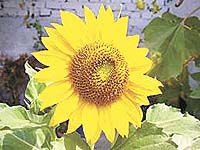| Sunflowers could be a very profitable crop for farmers in Emery County. |
Are sunflowers a good crop for Emery County farmers? Jeff Berman, from San Juan Bioenergy will be available from 5-6 p.m. to answer questions from anyone interested in raising biofuels crops such as sunflower, safflower or canola. This workshop will be on Feb. 13 at the Ferron Multi-purpose building. These crops are raised for the oil content and are used in the food market or in the biofuels market. Berman will explain their program, prices offered for the oil seeds, contracting, etc.
Emery County Economic Development Director, Mike McCandless has been involved in the biodiesel project for two years. He said sunflowers should do pretty well in Emery County because they are a native plant to this area. The San Juan Bioenergy group will be growing and buying sunflowers within a 200 mile radius of Dove Creek, Colo. where the processing plant will be located. It is anticipated that to meet the demands of the processing plant, up to 60,000 acres of sunflowers will be needed. A portion of the oil produced by the sunflowers will be sold for biodiesel. But most will be sold to food processors for food cooking. Since the trend in health has moved from the saturated fats to lighter oils, sunflower and related oils have taken the forefront in oil demand.
Tests have been conducted all around the Dove Creek area and it’s estimated that a farmer can raise sunflowers and receive approximately $510 per acre on irrigated land.
“Sunflowers typically take about half as much water as more traditional crops such as hay. You can receive a good income per acre using less water. In fact, many of the farmers in Colorado are going to dry farm their sunflower crops. The sunflowers needed for oil are a small black seed, similar to those found in bird seed. They produce the most oil without a lot of the plant strength going to size. The seed heads are approximately four-five inches across. Sunflowers have been bred specifically for this purpose. Once harvested,the shells are crushed to extract the oil and the by-product of the process produces a meal for use as a high protein cattle feed.
“There are a couple of farmers lined up in Emery County that are already interested in growing sunflower crops. The water situation is looking good this year, too. Last year we were reduced by 70 percent in our water allotments. This year the water is currently 125 percent and looking good. If it will stay cold for the next few months and then heat up quickly, the snowpack could fill local reservoirs,” said McCandless.
Sunflowers are native to the Americas. The earliest known examples of a fully domesticated sunflower were found at the Hayes site in Tennessee and date back to around 2300 B.C. There were also other remains found at the Olmec site of San Andr�s dating some time before 2100 B.C. The Incas used the sunflower as an image of their sun god. Gold images of the flower, as well as seeds, were taken back to Europe early in the 16th century.
To grow well, sunflowers need full sun. They grow best in fertile, moist, well-drained soil with a lot of mulch.
Sunflower “whole seed” (fruit) are sold as a snack food after roasting within heated ovens with or without salt added. Sunflowers can be processed into a peanut butter alternative, Sunbutter, especially in China, Russia, the United States, the Middle East and Europe. It is also sold as food for birds and can be used directly in cooking and salads.
Sunflower oil, extracted from the seeds, is used for cooking, as a carrier oil and to produce biodiesel, for which it is less expensive than the olive product. A range of sunflower varieties exist with differing fatty acid compositions; some ‘high oleic’ types contain a higher level of healthy monounsaturated fats in their oil than even olive oil.
The cake remaining after the seeds have been processed for oil is used as a livestock feed. Some recently developed cultivars have drooping heads. These cultivars are less attractive to gardeners growing the flowers as ornamental plants, but appeal to farmers, because they reduce bird damage and losses from some plant diseases. Sunflowers also produce latex and are the subject of experiments to improve their suitability as an alternative crop for producing hypoallergenic rubber.
For farmers growing other crops, the sunflower is considered a weed. The wild variety will grow unwanted in corn and soybean fields and can have a negative impact on yields.

